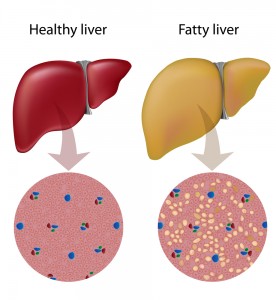America’s obesity rates have risen sharply over the last few decades and with that comes a rise in the number of individuals with nonalcoholic fatty liver disease (NAFLD). NAFLD is a very real and expanding health threat with approximately 30% of the adult population and 5% of children affected by this disease. NAFLD is the abnormal buildup of accumulated fat within the liver cells. While it is normal for the liver to contain some fat, if more than 5 – 10% of the liver weight is fat, a diagnosis of fatty liver may result. NAFLD is most likely to develop in people who are overweight, have diabetes or insulin resistance, high cholesterol or high triglycerides. In general, a person’s risk of liver disease increases with body mass. NAFLD is associated with other serious non-liver diseases such as cardiovascular disease and stroke.
NAFLD is considered a manifestation of metabolic syndrome and is divided into two categories. Isolated or simple fatty liver, in which there is excess fat accumulation, and nonalcoholic steatohepatitis (NASH) where, in addition to increased lipids, there is liver damage and inflammation that can lead to fibrosis and end-stage liver disease. Overall, morbidity and mortality is significantly higher in NASH patients compared with the general population. NAFLD is mostly asymptomatic and silent and is often diagnosed through blood tests showing elevated liver enzymes. The most familiar symptoms are generally feeling unwell, fatigue and abdominal discomfort.
When large amounts of fats are present in the body, such as with obesity, fat becomes metabolically active, resulting in inflammation and increased production of hormones and proteins that affect cells throughout the body, and in turn promotes insulin resistance. The liver is responsible for making and exporting fats throughout the body and cleansing fats that have been released by cells and tissues from the bloodstream. When the management of fats by the liver is unbalanced and increased amounts of fats are produced and decreased amounts are disposed of, fat accumulates in the liver. This accumulation of fats can begin with the classification of being overweight and with weights considered less than obese.
Treatment for NAFLD includes lifestyle changes, such as dietary modification, exercise, weight loss, and supplementation with omega-3 fatty acids and antioxidants such as vitamin E to reduce oxidative stress. A vitamin D deficiency may also be present with NAFLD. Even a small weight loss of 7% can result in a decrease in liver fat. Consistent, vigorous exercise will also reduce liver fat and may decrease inflammation. A diet with reduced amounts of unsaturated fats and high fructose corn syrup and increased amounts of healthy saturated fats appears to be beneficial. Getting treatment for underlying causes such as diabetes is essential.
Proactive ways to halt or reverse the effects of this disease:
- Do not smoke
- Limit alcohol consumption to one glass of wine per day
- Gradually lose weight until ideal weight is reached
- Get plenty of vigorous exercise
- Maintain normal cholesterol levels
- Avoid fast food and junk food
- Supplement with antioxidants
- Make the necessary dietary changes
- Treat diabetes and insulin resistance to keep glucose levels under control
- Reduce strain on the liver by treating related conditions such as hypertension
UltraMeal Plus 360 Medical Food by Metagenics – This low-glycemic index medical food is designed to nutritionally support the management of conditions associated with metabolic syndrome and cardiovascular disease. Variety of flavors available.
Vitamin D3 1000 IU by Pure Encapsulations – The many benefits of vitamin D include general cellular support, immune health support, calcium absorption and maintaining healthy glucose metabolism.
Clinical Nutrients for Diabetics by Integrative Therapeutics – Provides targeted nutritional support for diabetics with optimal levels of essential nutrients, antioxidants, vitamins and minerals.

